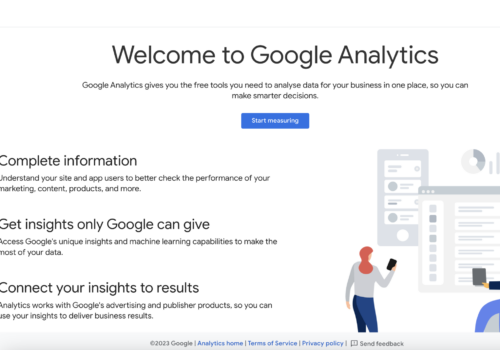Marketing is a science, not a superstition, because of measurement. For many business owners, marketing is an unnecessary investment that should be spent only when the budget allows it.
This is because, in many circumstances, the marketing return on investment is unexpected.
Your ad may be a huge success, bringing you thousands of new clients, or it could be a complete flop, squandering your time and money.
Solid metrics provide you with the information you need to face the challenge of unpredictability. If you’re just getting started or need to revamp your current marketing plan, educate yourself with the following:
Online Marketing Metrics: 10 Important Things To Measure
Source: Pexels
1. Total Visits:
Your main website should be your primary objective for consumers and potential customers, but you may track total visits to any area relevant to your plan, such as a pay-per-click landing page.
Measuring total visits will offer you a “big picture” image of how successfully your campaign is attracting traffic.
If you observe a dip in your statistics from month to month, you’ll know it’s time to examine one of your marketing channels to determine why.
In a healthy, consistent campaign, you should expect your overall number of visitors to slowly increase.
2. New Sessions:
The total number of new sessions is a Google Analytics indicator that tells you how many of your site visitors are new and how many are returning.
It’s an important indicator to grasp since it indicates whether your site is sticky enough to entice return visitors as well as the effectiveness of your outreach activities.
For example, make substantial changes to your site’s structure or content, and your recurring visitor-to-new visitor ratio falls. This might indicate that your site is losing its efficacy in attracting repeat visitors.
3. Channel-Specific Traffic:
Source: Pexels
Your channel-specific metrics, which can be found in Google Analytics “Acquisition” section, will separate your traffic based on where it came from.
Because “total visitors” cannot tell you which channels are outperforming the others, this is especially important for a full-scale digital marketing strategy. The following are the four key channels to keep an eye on:
a. “Direct”, which will inform you how many individuals came straight to your site;
b. “Referrals”, or external links from other websites;
c. “Organic”, which includes visitors that discovered you through a search, and;
d. “Social”, which refers to users who came to your site via social media. This is a great method for evaluating the performance of your SEO, social media marketing, content marketing, and traditional marketing strategies.
4. Bounce Rate:
The bounce rate is the percentage of visitors that depart your website without investigating it further.
Potential visitors will be judged to have “bounced” if they arrive at your homepage after looking for you and leave without clicking any more links.
In general, you want to keep your bounce rate as low as possible since the longer someone remains on your site, the more likely they are to convert and take action.
5. Total Conversions:
Source: Pexels
One of the most essential indicators for determining the profitability of your marketing activities is total conversions.
While conversion may be defined in various ways (for example, filling out a lead form or checking out on an e-commerce site), conversions are always viewed as a quantitative triumph in the eyes of a marketer.
Depending on how your site is constructed, you may monitor conversions directly on it or set up a target in Google Analytics to track your progress.
Insufficient design, poor offerings, or simply uninterested visitors might all contribute to low conversion rates.
6. Lead to Close Ratio:
This is more of a measure of your sales performance than of your marketing efforts, but it’s still crucial to know in the context of your total return on investment.
Any leads you acquire from marketing might be meaningless if you don’t follow up with them in a timely and effective manner.
Simply divide your total number of sales by your total number of leads to achieve a ratio that characterizes your sales performance independent of your marketing activities.
If your close rate is poor, any loss in income or expenditure might indicate inefficient final sales methods.
7. Customer Retention Rate:
Source: Pexels
If your buy cycle is long or your business focuses on one-time-only sales, customer retention might be tough to assess.
Subscription-based services, e-commerce platforms, and most traditional companies, on the other hand, may track client retention by determining the percentage of consumers who return to make another purchase.
A poor customer retention number might indicate a product or service that isn’t sticky or a lack of outreach activities.
Customer retention is also a key aspect in determining a customer’s average value.
8. Customer Value:
Source: Pexels
Calculating customer value is challenging. It won’t tell you how well your sales or marketing activities are performing, but it will help you determine your overall return on investment.
It can also help you determine your company’s annual goals.
To calculate your average customer value, add up all of the sales that your average customer will make throughout the duration of your partnership.
Calculating this for a startup is very hard, but you may make a decent approximation based on the number of transactions per client each year.
9. Cost Per Lead:
Your cost per lead is determined by the approach you followed for each lead generation channel, making it a far more detailed measure than some of the “big picture” metrics we mentioned before.
Take a look at the average monthly cost of your selected campaign and compare it to the total number of leads you generated with that channel over the same period to figure out your cost per lead.
Your cost per lead would be $50 if you spent $500 on advertising for a pay-per-click campaign and received 10 total conversions during the same period.
Make careful to account for “invisible” expenditures like management time, starting fees, and other charges.
10. Estimated Return on Investment:
Your return on investment (ROI) is the most significant aspect of any marketing campaign since it shows how profitable it is.
A good ROI suggests that your marketing approach is working, but a negative ROI indicates that you need to make some changes.
You’ll compare your cost per lead to your lead-to-close ratio, then compare that amount to your average customer value to determine your campaign’s ROI. For example, if you spend $50 per lead and close 50% of your leads, each successful new customer would cost you $100.
In this case, if your average customer value is greater than $100, you’ve made a profit, and your marketing effort is a success.
Checking these indicators on a regular basis will provide you with an accurate picture of the health of your digital marketing effort.
Over time, you’ll be able to fine-tune your techniques, study which strategies perform best and why, and develop a consistent marketing rhythm that generates enough leads to cover your marketing expenditures and earn a considerable profit.
FAQs
🤔 What are the key online marketing metrics I should be tracking?
The key online marketing metrics you should track include website traffic, conversion rate, bounce rate, click-through rate (CTR), email open rate, social media engagement, return on investment (ROI), and customer lifetime value (CLV).
📈 How do I measure the success of my online marketing campaigns?
You can measure the success of your online marketing campaigns by analyzing various metrics such as website traffic, conversion rates, sales, engagement on social media platforms, email open rates, click-through rates, and ROI.
💻 Why is it essential to track website traffic metrics?
Tracking website traffic metrics helps you understand how visitors interact with your site, which pages are most popular, where they come from, and how they behave. This information enables you to optimize your website for better user experience and conversions.
📧 How do I measure the effectiveness of my email marketing efforts?
You can measure the effectiveness of your email marketing efforts by tracking metrics such as open rates, click-through rates, conversion rates, and unsubscribe rates. Analyzing these metrics helps you understand how engaged your subscribers are and identify opportunities for improvement.
💻 Why is it essential to track website traffic metrics?
Tracking website traffic metrics is essential because it helps you understand how users interact with your site, which pages are popular, where visitors come from, and their behaviour. This data enables you to optimize your website for better user experience and conversions.
Quick Links:
- Why Typography is Important in Online Marketing
- Discussing Online Marketing and SEO Strategies
- Best Online Growth Hacking Courses
- What is EPC in Affiliate Marketing And How Can It Be Calculated?
Conclusion: Online Marketing Metrics To Consider In 2025
Track your online marketing progress by watching important numbers!
Check things like website visitors, how many people buy, and how engaged customers are. These numbers help you see if your marketing is working well or if it needs tweaking.
By paying attention to stuff like how many people leave your site quickly or how often people click on your ads, you can make your marketing even better and reach your business goals easier.









